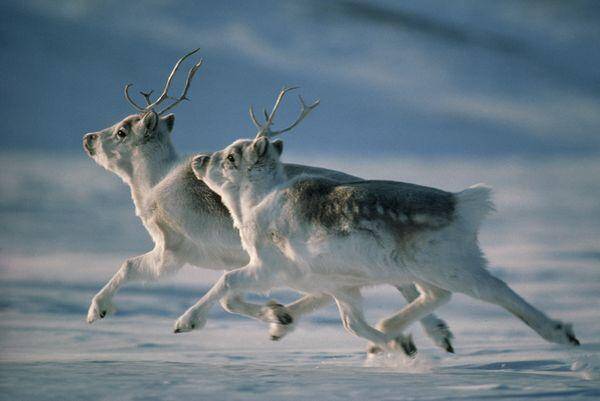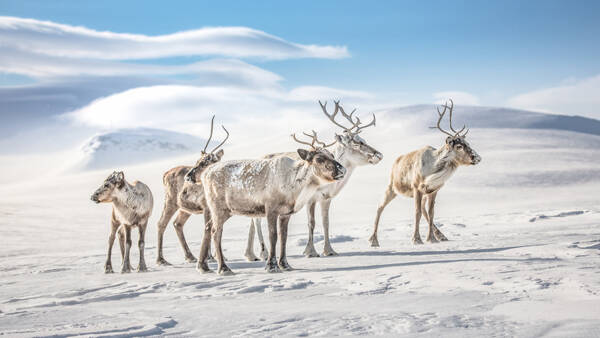Rangifer tarandus
IUCN
LCBasic Information
Scientific classification
- name:Rangifer tarandus
- Scientific Name:Rangifer tarandus,Reindeer
- Outline:Ungulata
- Family:Artiodactyla Cervidae Reindeer
Vital signs
- length:120-220cm
- Weight:60-318kg
- lifetime:About 20 years
Feature
Both males and females have horns, and the complex branching of the horns is an important feature of their appearance.
Distribution and Habitat
Distributed in Eurasia, North America, and southern Siberia. The Chinese subspecies is distributed in the northwest slope of Greater Khingan Range, and only a small number of them are still raised in Genhe City, Inner Mongolia Autonomous Region.
Origin: Canada, Finland, Greenland, Mongolia, Norway, Russian Federation, Svalbard and Jan Mayen Island, United States.
Regional extinction: Sweden.
Reindeer are circumpolar animals, widely distributed in Eurasia and the northern part of North America and some large islands. In addition, they are artificially introduced to South Georgia Island and survive well. According to research, China's reindeer are related to the reindeer in the Wendo Tundra Highlands in the upper reaches of the Nerchinsk River in the northeast of Lake Baikal.
They live in the cold temperate coniferous forests and are in a semi-wild state. The main food is litmus, and they also eat horsetail, mushrooms and young branches and leaves of woody plants. The Ew
Appearance
Reindeers are of medium size, with a head and body length of 120-220 cm; shoulder height of 87-140 cm; male antlers are 52-130 cm long, and female antlers are 23-80 cm long; weight is 60-318 kg.
Both males and females have horns; the antlers are bent forward, and the branches are forked. Male deer shed their antlers in March, while female deer shed their antlers a little later, around mid- to late April. Reindeers have long and straight heads, thick mouths, well-developed lips, large eyes, prominent eye sockets, large nostrils, thick and short necks, obvious drooping, no nose, short hair growing on the nostrils, short ears like horse ears, and concave foreheads; long necks, slightly raised shoulders, straight backs and waists; short tails; large and wide main hooves, deep central fissures, large hanging hooves, and wide palms. They are the largest among deer species and can touch the ground when walking, so they are suitable for walking on snow and rugged roads. The calves begin to
Details
Reindeer (scientific name: Rangifer tarandus) is called Reindeer in foreign language. There are 17 subspecies. Also known as horned deer, it is the only animal under the genus Reindeer in the family Cervidae.

The most amazing behavior of reindeer is the annual migration of hundreds of kilometers. As soon as spring arrives, they leave the forests and grasslands of the subarctic region where they hibernate, and head north along the same route that has remained unchanged for hundreds of years. And the female deer always lead the way, followed by the male deer, in an orderly manner, driving straight ahead, eating as they go, traveling day and night, taking off their thick winter clothes along the way, and growing new thin summer clothes. The shed fur falls on the ground and becomes a signpost. This goes on year after year, and it is unknown how many centuries they have walked. Reindeer always move at a constant speed. Only when they are disturbed by wolves or chased by hunters will they run violently, making a loud noise that shakes the earth, raising dust all over the sky, breaking the tranquility of the grassland, and starting a competition for life on the originally silent Arctic land.
The growth rate of young reindeer is unmatched by any other animal. The female deer conceives in winter and gives birth during the spring migration. The calves can follow the mother deer two or three days after birth. After a week, they can run as fast as their parents, up to 48 kilometers per hour.
The main food of reindeer is litmus, and they also eat horsetail, mushrooms and young branches and leaves of woody plants. Artificial breeding requires regular feeding with salt, building fences to smoke mosquitoes in summer, and helping the mother deer take care of the calves during the birthing period, and driving away natural enemies such as wolves and bears. The rest of the time, reindeer are free to forage in the forest without supervision.

The reindeer mating season is from mid-September to October each year. The competition for females is fierce, and the sexual cycle is 13-22 days. The conception rate is high, the gestation period is 225-240 days, and the calves are born in April and May. One calves are born each time, and occasionally two calves are born. The lactation period is 165-180 days. Female deer reach sexual maturity at 1.5 years old. Some well-developed individuals can participate in reproduction in the same year. They have strong reproductive capacity until they are 14 years old. Male deer reach sexual maturity later. Reindeer can live up to 20 years.
Reindeer is the most numerous species in the deer family. According to surveys, there were 3.9 million wild reindeer in the world in 1986. The former Soviet Union was the country with the most reindeer. According to statistics in 1985, there were 980,000 wild reindeer in Russia and 2.23 million semi-domestic reindeer, with an annual utilization of about 15-20%. Chinese reindeer are all semi-domestic populations. Due to long-term inbreeding, genetic decline is serious, coupled with diseases and natural enemies, the number of lives and deaths is roughly balanced. From 1950 to 2000, the number of reindeers has been hovering around 1,000, 853 in 1939, 400 in 1945, 629 in 1957, 795 in 1967, 955 in 1976, and 904 in 1985.
The sleigh that Santa Claus rides is pulled by reindeers. The leading reindeer is named Rudolph and has a red nose. There are 9 reindeers pulling Santa Claus' sleigh: Rudolph, Dasher, Dancer, Prancer, Vixen, Donder, Blitzen, Cupid (Comet) Comet. Eight reindeers are responsible for pulling, and one of them, "Rudolph the Red-Nosed", is the leading reindeer.

The endangered factors of reindeer are genetic decline and disease. The existing protection measures are based on the animal husbandry contract responsibility system, with group responsibility and contracted to Ewenki hunters with management experience, and the number of reindeer and nomadic areas are allocated according to labor and household. In addition, the Ergun Left Banner Animal Husbandry Bureau regularly selects experienced veterinarians to go up the mountain to check and treat reindeer. Reindeer are the meat source of northern ethnic groups living near the Arctic Circle. They also use their fur, milk or as a means of transportation. For example, the Indians in North America, the Sakharians on the Kola Peninsula and the Evenks in northern Asia are very similar. They all attach great importance to the management and protection of reindeer. The International Reindeer Conference is held every three years to exchange experiences in the research, protection, management and rational use of reindeer in various countries.
The Evenks are the only ethnic group in China that raises reindeer. Over the long years of history, reindeer have made important contributions to the daily life and production of the Evenks. After the ancient Evenks captured the wild animal "Sogzhao", they gradually domesticated it into today's reindeer in long-term production practice. Reindeer in the Evenk language is called "Aolun", and both male and female reindeer have horns. Reindeer are good at crossing forests and swamps. They are the main means of production and transportation for hunting Ewenki hunters. Reindeer have become an indispensable and precious economic animal in the daily life of the Ewenki people. They are known as the "ship of the forest sea" and are national second-class protected animals.
Listed in the 2015 Red List of Endangered Species of the World Conservation Union (IUCN) ver 3.1-Vulnerable (VU).
Listed in the "China Red Book of Endangered Animals" with a level of Vulnerable, effective in 1996.
Protect wild animals and eliminate game.
Maintaining ecological balance is everyone's responsibility!








